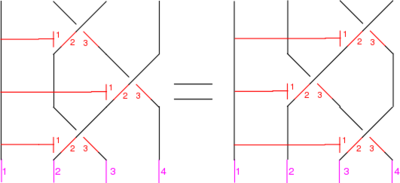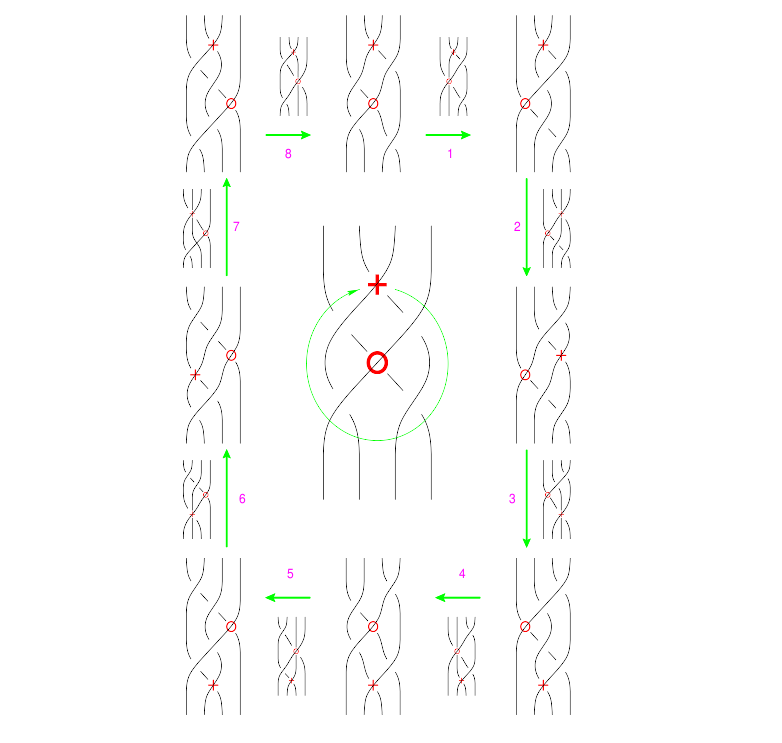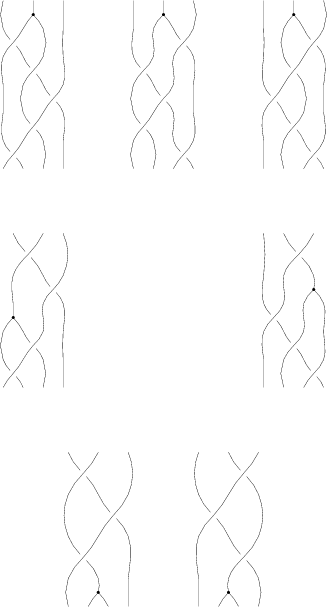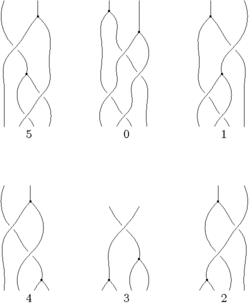User:Andy/06-1350-HW4: Difference between revisions
(Copied the assignment.) |
mNo edit summary |
||
| (8 intermediate revisions by 2 users not shown) | |||
| Line 27: | Line 27: | ||
===The Relations=== |
===The Relations=== |
||
====The Reidemeister Move R2==== |
|||
The following version of R2 was the easiest to use to build my [[media:06-1350-PhiAroundPhi.png|original <math>\Phi</math> around <math>\Phi</math> syzygy]]: |
|||
[[Image:06-1350-R2-weird.png|center]] |
|||
In formulas, this is |
|||
<center><math>1 = (123)^\star B^- (132)^\star B^+.</math></center> |
|||
Linearized and written in functional form, this becomes |
|||
{| align=center |
|||
|- |
|||
|<math>\rho_2(x_1,x_2,x_3) = - b^-(x_1,x_2,x_3) - b^+(x_1,x_3,x_2).</math> |
|||
|} |
|||
====The Reidemeister Move R3==== |
====The Reidemeister Move R3==== |
||
| Line 42: | Line 53: | ||
|<math>- b^+(x_1+x_2,x_3,x_4) - b^+(x_1,x_2,x_4) - b^+(x_1+x_4,x_2,x_3).</math> |
|<math>- b^+(x_1+x_2,x_3,x_4) - b^+(x_1,x_2,x_4) - b^+(x_1+x_4,x_2,x_3).</math> |
||
|} |
|} |
||
====The Reidemeister Move R4==== |
|||
To establish the syzygy below, I needed two versions of R4. First: |
|||
[[Image:06-1350-R4a.png|center]] |
|||
In formulas, this is |
|||
<center><math>(1230)^\star B^+ (1213)^\star B^+ (1023)^\star \Phi = (1123)^\star \Phi (1233)^\star B^+</math>.</center> |
|||
Linearized and written in functional form, this becomes |
|||
{| align=center |
|||
|- |
|||
|<math>\rho_{4a}(x_1,x_2,x_3,x_4) = b^+(x_1,x_2,x_3) + b^+(x_1+x_3,x_2,x_4) + \phi(x_1,x_3,x_4) - \phi(x_1+x_2,x_3,x_4) - b^+(x_1,x_2,x_3+x_4).</math> |
|||
|} |
|||
Second: |
|||
[[Image:06-1350-R4b.png|center]] |
|||
In formulas, this is |
|||
<center><math>(1123)^\star B^+ (1203)^\star B^+ (1231)^\star \Phi = (1230)^\star \Phi (1223)^\star B^+</math>.</center> |
|||
Linearized and written in functional form, this becomes |
|||
{| align=center |
|||
|- |
|||
|<math>\rho_{4b}(x_1,x_2,x_3,x_4) = b^+(x_1+x_2,x_3,x_4) + b^+(x_1,x_2,x_4) + \phi(x_1+x_4,x_2,x_3) - \phi(x_1,x_2,x_3) - b^+(x_1,x_2+x_3,x_4).</math> |
|||
|} |
|||
Are these independent, or can they be shown to be equivalent using other relations? |
|||
===The Syzygies=== |
===The Syzygies=== |
||
| Line 67: | Line 101: | ||
| |
| |
||
|<math>+ \rho_3(x_1, x_3, x_4, x_5) + \rho_3(x_1 + x_3, x_2, x_4, x_5).</math> |
|<math>+ \rho_3(x_1, x_3, x_4, x_5) + \rho_3(x_1 + x_3, x_2, x_4, x_5).</math> |
||
|} |
|||
====The "<math>\Phi</math> around B" Syzygy==== |
|||
The picture, with all shielding (and any other helpful notations) removed, is |
|||
{| align=center |
|||
|- align=center |
|||
|[[Image:06-1350-PhiAroundB.png|center]] |
|||
|- |
|||
|align=right|(Drawn with [http://asymptote.sf.net/ Asymptote], [[06-1350/Syzygies in Asymptote|Syzygies in Asymptote]]) |
|||
|} |
|||
The functional form of this syzygy is |
|||
{| align=center |
|||
|- |
|||
|<math>\Phi B(x_1,x_2,x_3,x_4,x_5) = </math> |
|||
|<math>\rho_3(x_1,x_2,x_3,x_5) + \rho_{4a}(x_1+x_5,x_2,x_3,x_4) + \rho_{4b}(x_1+x_2,x_3,x_4,x_5)</math> |
|||
|- |
|||
| |
|||
|<math>- \rho_3(x_1,x_2,x_3+x_4,x_5) - \rho_{4a}(x_1,x_2,x_3,x_4)</math> |
|||
|- |
|||
| |
|||
|<math>- \rho_{4b}(x_1,x_3,x_4,x_5) + \rho_3(x_1+x_3,x_2,x_4,x_5).</math> |
|||
|} |
|||
====The "<math>\Phi</math> around <math>\Phi</math>" Syzygy==== |
|||
The original syzygy is available at [[:Image:06-1350-PhiAroundPhi.png]]. |
|||
A cleaner, minimal picture is |
|||
{| align=center |
|||
|- align=center |
|||
|[[Image:06-1350-PhiAroundPhiClean.png|center]] |
|||
|- |
|||
|align=right|(Drawn with [http://asymptote.sf.net/ Asymptote], [[06-1350/Syzygies in Asymptote|Syzygies in Asymptote]]) |
|||
|} |
|||
The functional form of this syzygy is |
|||
{|align=center |
|||
|- |
|||
|<math>\Phi\Phi(x_1,x_2,x_3,x_4,x_5) = </math> |
|||
|<math>\rho_{4b}(x_1+x_4,x_2,x_3,x_5) + \rho_{4b}(x_1,x_2,x_3,x_4) + \rho_{4a}(x_1,x_2+x_3,x_4,x_5)</math> |
|||
|- |
|||
| |
|||
|<math>- \rho_{4b}(x_1,x_2,x_3,x_4+x_5) - \rho_{4a}(x_1+x_2,x_3,x_4,x_5) - \rho_{4a}(x_1,x_2,x_4,x_5).</math> |
|||
|} |
|} |
||
Latest revision as of 17:35, 5 December 2006
The Generators
Our generators are , , and :
| Picture | 
|
||||
| Generator | |||||
| Perturbation |
The Relations
The Reidemeister Move R2
The following version of R2 was the easiest to use to build my original around syzygy:
In formulas, this is
Linearized and written in functional form, this becomes
The Reidemeister Move R3
The picture (with three sides of the shielding removed) is
In formulas, this is
Linearized and written in functional form, this becomes
The Reidemeister Move R4
To establish the syzygy below, I needed two versions of R4. First:
In formulas, this is
Linearized and written in functional form, this becomes
Second:
In formulas, this is
Linearized and written in functional form, this becomes
Are these independent, or can they be shown to be equivalent using other relations?
The Syzygies
The "B around B" Syzygy
The picture, with all shielding removed, is
| (Drawn with Inkscape) (note that lower quality pictures are also acceptable) |
The functional form of this syzygy is
The " around B" Syzygy
The picture, with all shielding (and any other helpful notations) removed, is
| (Drawn with Asymptote, Syzygies in Asymptote) |
The functional form of this syzygy is
The " around " Syzygy
The original syzygy is available at Image:06-1350-PhiAroundPhi.png. A cleaner, minimal picture is
| (Drawn with Asymptote, Syzygies in Asymptote) |
The functional form of this syzygy is
A Mathematica Verification
The following simulated Mathematica session proves that for our single relation and single syzygy, . Copy paste it into a live Mathematica session to see that it's right!
In[1]:=
|
d1 = {
rho3[x1_, x2_, x3_, x4_] :> bp[x1, x2, x3] + bp[x1 + x3, x2, x4] +
bp[x1, x3, x4] - bp[x1 + x2, x3, x4] - bp[x1, x2, x4] -
bp[x1 + x4, x2, x3]
};
d2 = {
BAroundB[x1_, x2_, x3_, x4_, x5_] :> rho3[x1, x2, x3, x5] +
rho3[x1 + x5, x2, x3, x4] - rho3[x1 + x2, x3, x4, x5] -
rho3[x1, x2, x4, x5] - rho3[x1 + x4, x2, x3, x5] -
rho3[x1, x2, x3, x4] + rho3[x1, x3, x4, x5] +
rho3[x1 + x3, x2, x4, x5]
};
|
In[3]:=
|
BAroundB[x1, x2, x3, x4, x5] /. d2
|
Out[3]=
|
- rho3[x1, x2, x3, x4] + rho3[x1, x2, x3, x5] - rho3[x1, x2, x4, x5]
+ rho3[x1, x3, x4, x5] - rho3[x1 + x2, x3, x4, x5]
+ rho3[x1 + x3, x2, x4, x5] - rho3[x1 + x4, x2, x3, x5]
+ rho3[x1 + x5, x2, x3, x4]
|
In[4]:=
|
BAroundB[x1, x2, x3, x4, x5] /. d2 /. d1
|
Out[4]=
|
0
|






































